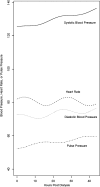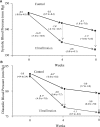Assessment and management of hypertension in patients on dialysis
- PMID: 24700870
- PMCID: PMC4116052
- DOI: 10.1681/ASN.2013060601
Assessment and management of hypertension in patients on dialysis
Abstract
Hypertension is common, difficult to diagnose, and poorly controlled among patients with ESRD. However, controversy surrounds the diagnosis and treatment of hypertension. Here, we describe the diagnosis, epidemiology, and management of hypertension in dialysis patients, and examine the data sparking debate over appropriate methods for diagnosing and treating hypertension. Furthermore, we consider the issues uniquely related to hypertension in pediatric dialysis patients. Future clinical trials designed to clarify the controversial results discussed here should lead to the implementation of diagnostic and therapeutic techniques that improve long-term cardiovascular outcomes in patients with ESRD.
Keywords: dialysis; hemodialysis; hypertension.
Copyright © 2014 by the American Society of Nephrology.
Figures


References
-
- Agarwal R, Nissenson AR, Batlle D, Coyne DW, Trout JR, Warnock DG: Prevalence, treatment, and control of hypertension in chronic hemodialysis patients in the United States. Am J Med 115: 291–297, 2003 - PubMed
-
- Salem MM: Hypertension in the hemodialysis population: A survey of 649 patients. Am J Kidney Dis 26: 461–468, 1995 - PubMed
-
- Rocco MV, Yan G, Heyka RJ, Benz R, Cheung AK, HEMO Study Group : Risk factors for hypertension in chronic hemodialysis patients: Baseline data from the HEMO study. Am J Nephrol 21: 280–288, 2001 - PubMed
-
- Raine AE, Margreiter R, Brunner FP, Ehrich JH, Geerlings W, Landais P, Loirat C, Mallick NP, Selwood NH, Tufveson G: Report on management of renal failure in Europe, XXII, 1991. Nephrol Dial Transplant 7[Suppl 2]: 7–35, 1992 - PubMed
-
- Rahman M, Fu P, Sehgal AR, Smith MC: Interdialytic weight gain, compliance with dialysis regimen, and age are independent predictors of blood pressure in hemodialysis patients. Am J Kidney Dis 35: 257–265, 2000 - PubMed
Publication types
MeSH terms
Substances
Grants and funding
LinkOut - more resources
Full Text Sources
Other Literature Sources
Medical

